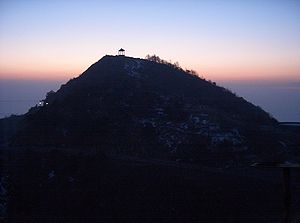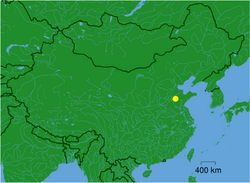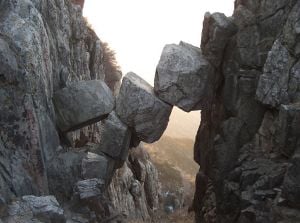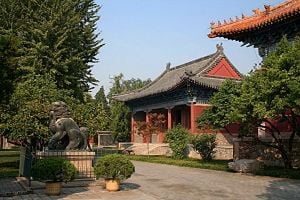Difference between revisions of "Mount Tai" - New World Encyclopedia
Chris Jensen (talk | contribs) |
Chris Jensen (talk | contribs) |
||
| Line 26: | Line 26: | ||
| Link = http://whc.unesco.org/en/list/437 | | Link = http://whc.unesco.org/en/list/437 | ||
}} | }} | ||
| − | '''Mount Tai''' ( | + | '''Mount Tai''' (Chinese: 泰山; Pinyin: ''Tài Shān'') is a mountain of historical and cultural significance located north of the city of Tai'an, in Shandong Province, [[China]]. The tallest peak is ''[[Jade Emperor]] Peak'' (Simplified Chinese: 玉皇顶; Traditional Chinese: 玉皇頂; Pinyin: ''Yùhuáng Dīng''), which is commonly reported as 1545 metres (5069 feet) tall<ref name="forestrystudy">{{cite journal |last= |first= |authorlink= |coauthors= |year=2000 |month= |title=Studies on the diversity of soil animals in Taishan Mountain |journal=Journal of Forestry Research |volume=11 |issue=2 |pages=109-113 |id= |url=http://www.wanfangdata.com.cn/qikan/periodical.articles/lyyj/lyyj2000/0002/000208.htm |accessdate=4 June 2007 |quote= }}</ref>, but is described by the Chinese government as 1532.7 metres (5028.5 feet)<ref name="govtpeaks">[http://www.cigem.gov.cn/ReadNews.asp?NewsID=11093 China Announced Elevation of 19 Well-known Mountains], China Institute of Geo-Environment Monitoring, 19 May 2007. Accessed 4 June 2007.</ref>. |
| − | Mount Tai is one of the "[[Sacred Mountains of China|Five Sacred Mountains of Taoism]]". It is associated with sunrise, birth, and renewal, and is often regarded the foremost of the five. The temples on its slopes have been a destination for pilgrims for 3,000 years. | + | Mount Tai is one of the "[[Sacred Mountains of China|Five Sacred Mountains of Taoism]]". It is associated with sunrise, birth, and renewal, and is often regarded the foremost of the five.<ref>Terry F. Kleeman, "Mountain Deities in China: The Domestication of the Mountain God and the Subjugation of the Margins," ''Journal of the American Oriental Society'' 114:2 (April 1994), 226-238. 230.</ref> The temples on its slopes have been a destination for pilgrims for 3,000 years. Further, it has since ancient times been associated with rulership, to the extent that scaling to the highest peak was understood to ritually invest a ruler with the charisma of office. |
==Geology and Geography== | ==Geology and Geography== | ||
Revision as of 03:58, 25 November 2007
| Mount Tai | |
|---|---|
| 300px A Daoist Temple on a cliff-side at Tai Shan (泰山) | |
| Elevation | 1532.7 metres (5,028.5 feet) |
| Location | Shandong, China |
| Geographic coordinates | 36°15′N 117°06′E |
| Type | metamorphic, sedimentary |
| Geologic time scale | Cambrian |
| Easiest Climbing route | cable car |
| Mount Taishan* | |
|---|---|
| UNESCO World Heritage Site | |

| |
| State Party | |
| Type | Mixed |
| Criteria | i, ii, iii, iv, v, vi, vii |
| Reference | 437 |
| Region** | Asia-Pacific |
| Inscription history | |
| Inscription | 1987 (11th Session) |
| * Name as inscribed on World Heritage List. ** Region as classified by UNESCO. | |
Mount Tai (Chinese: 泰山; Pinyin: Tài Shān) is a mountain of historical and cultural significance located north of the city of Tai'an, in Shandong Province, China. The tallest peak is Jade Emperor Peak (Simplified Chinese: 玉皇顶; Traditional Chinese: 玉皇頂; Pinyin: Yùhuáng Dīng), which is commonly reported as 1545 metres (5069 feet) tall[1], but is described by the Chinese government as 1532.7 metres (5028.5 feet)[2].
Mount Tai is one of the "Five Sacred Mountains of Taoism". It is associated with sunrise, birth, and renewal, and is often regarded the foremost of the five.[3] The temples on its slopes have been a destination for pilgrims for 3,000 years. Further, it has since ancient times been associated with rulership, to the extent that scaling to the highest peak was understood to ritually invest a ruler with the charisma of office.
Geology and Geography
Mount Tai is a tilted fault-block mountain with height increasing from the north to the south. It is the oldest example of a paleo-metamorphic formation from the Cambrian Period in eastern China. Known as the Taishan Complex, this formation contains magnetized, metamorphic, and sedimentary rock as well as intrusions of other origins during the Archean Era. The uplift of the region started in the Proterozoic Era, by the end of the Proterozoic, it had become part of the continent.
Besides the Jade Emperor Peak, other distinctive rock formations are the Heaven Candle Peak, the Fan Cliff, and the Rear Rock Basin.
Mount Tai lies in the zone of oriental deciduous forest; about 80% of its area is covered with vegetation. The flora is known to comprise almost 1,000 species. Some of the trees in the area are very old and have cultural significance, such as the Han Dynasty Cypresses, which were planted by the Emperor Wu Di, the Tang Chinese Scholartree (about 2,100 years old), the Welcoming-Guest Pine (500 years old) and the Fifth-Rank Pine, which was named originally by the Emperor Qin Shi Huang, but was replanted about 250 years ago.[4]
Location
Mount Tai is located just north of the city of Tai'an and to the south of the provincial capital Jinan. It extends from 150 to 1,545 metres above sea level and covers an area of 426 square kilometres at its base. The Jade Emperor Peak is located at 36° 16′N and 117° 6′E.
History
Traces of human presence at Mount Tai date back to the Paleolithic period. Human settlement of the area can be proven from the neolithic period onwards. During this time, two cultures had emerged near the mountain, the Dawenkou to the north and Longshan to the south. In the Spring and Autumn Period, the mountain lay on the boundary between the competing States of Qi (north of the mountain) and Lu (south). In the ensuing Warring States Period, the State of Qi erected a 500 km-long wall to protect itself against an invasion. Ruins of this wall are still present today. The name Tai'an of neighboring city is attributed to the saying "If Mount Tai is stable, so is the entire country" (both characters of Tai'an, 泰安, have independent meaning "peace").
Religious worship of Mount Tai has a tradition of 3,000 years, it has been practiced from the time of the Shang to that of the Qing Dynasty. Over time, this worship evolved into an official imperial rite and Mount Tai became one of the principal places where the emperor would pay homage to Heaven (on the summit) and Earth (at the foot of the mountain) in the Fengshan Sacrifices (封禪). In 219 B.C.E., Qin Shi Huang, the first Emperor of China, held a ceremony on the summit and proclaimed the unity of his empire in a famous inscription.
Mount Tai has been a UNESCO World Heritage Site since 1987. In 2003, it attracted around 6 million visitors. A renovation project to be completed by late October 2005 aims at restoring cultural relics and the renovation of damaged buildings of cultural significance. Modern buildings which are inconsistent with the historic landscape are to be demolished. The total cost of the work is estimated at 15 million yuan (approximately US$1.8 million).[5]
Cultural significance
In total, there are 22 temples, 97 ruins, 819 stone tablets, and 1,018 cliff-side and stone inscriptions located on Mount Tai. A flight of 7,200 total steps (including inner temple Steps), with 6,293 Official Mountain Walkway Steps, lead up the East Peak of Mount Tai, along its course, there are 11 gates, 14 archways, 14 kiosks, and 4 pavilions.
The Temple of the God of Mount Tai, known as the Dai Temple (Dai Miao) is the largest and most complete ancient building complex in the area. It is located at the foot of Mount Tai in the city of Tai'an and covers an area of 96,000 square meters. The temple was first built during the Qin Dynasty. Since the time of the Han Dynasty (206 B.C.E. - 220 C.E.), its design has been a replica of the imperial palace, which makes it one out of three extant structures in China with the features of an imperial palace (the other two are the Forbidden City and the Confucius Temple in Qufu). The temple has five major halls and many small buildings. The centerpiece is the Palace of Heavenly Blessings (Tian Kuang), built in 1008, during the Northern Song Dynasty. The hall houses the mural painting "The God of Mount Tai Making a Journey", dated to the year 1009. The mural extends around the eastern, western and northern walls of the hall and is 3.3 metres high and 62 metres long. The theme of the painting is an inspection tour by the god. Next to the Palace of Heavenly Blessings stand the Yaocan Pavilion and the entrance archway as well as the Bronze Pavilion in the northeast corner. The Dai Temple is surrounded by the 2,100 year-old Han Dynasty cypresses.
Other major temples on the mountain include the Azure Cloud Temple dedicated to the daughter of the God of Mount Tai, the goddess Laomu and the Divine Rock Temple which features the Thousand-Buddhas Hall with painted Arhat statues.
- The Chinese idiom "泰山北斗" (lit. Mount Tai & Big Dipper) is an epithet for a person of great distinction.
- According to an ancient quotation from Sima Qian, "Though death befalls all men alike, it may be weightier than Mount Tai or lighter than a feather." Mao Zedong referenced this quote in the 20th century: "To die for the people is weightier than Mount Tai, but to work for the fascists and die for the exploiters and oppressors is lighter than a feather". [1] Rage Against the Machine referenced this in the song "Year of tha Boomerang": "So I'm goin' out heavy sorta like Mount Tai".
- In 1987, Canadian progressive rock band Rush put out the Hold Your Fire album, containing the song "Tai Shan." The song was about drummer and lyricist Neil Peart's journey to Mount Tai.
- Tai Shan is the name of the most popular beer of most of Western Shandong province.
Infrastructure
Visitors can reach the peak of Mount Tai via a bus which terminates at the Midway Gate to Heaven, from there a cable car connects to the summit. Covering the same distance on foot takes from two and a half to six hours. The supplies for the many vendors along the road to the summit are carried up by porters either from the Midway Gate to Heaven or all the way up from the foot of the mountain.
To climb up the mountain, one can take one of two routes. The more popular east route starts from Taishan Arch. On the way up the 7,200 stone steps, the climber first passes the Ten Thousand Immortals Tower (Wanxianlou), Arhat Cliff (Luohanya), and Palace to Goddess Dou Mu (Doumugong). The climbing from downtown up the mountain can take two and a half hours for the avid hiker to six hours for the leisure pace. To the northeast of the Palace to Goddess Dou Mu is Sutra Rock Valley in which the Buddhist Diamond Sutra was cut in characters measuring fifty centimeters across believed to be inscribed in the Northern Wei Dynasty. The west route, taken by less tourists, is more scenic with less culture heritages.
Footnotes
- ↑ (2000)Studies on the diversity of soil animals in Taishan Mountain. Journal of Forestry Research 11 (2): 109-113.
- ↑ China Announced Elevation of 19 Well-known Mountains, China Institute of Geo-Environment Monitoring, 19 May 2007. Accessed 4 June 2007.
- ↑ Terry F. Kleeman, "Mountain Deities in China: The Domestication of the Mountain God and the Subjugation of the Margins," Journal of the American Oriental Society 114:2 (April 1994), 226-238. 230.
- ↑ Some material retrieved from Mount-tai.com.
- ↑ Some material retrieved from Mount-tai.com.
ReferencesISBN links support NWE through referral fees
External links
- All links retrieved October 24, 2007
Credits
New World Encyclopedia writers and editors rewrote and completed the Wikipedia article in accordance with New World Encyclopedia standards. This article abides by terms of the Creative Commons CC-by-sa 3.0 License (CC-by-sa), which may be used and disseminated with proper attribution. Credit is due under the terms of this license that can reference both the New World Encyclopedia contributors and the selfless volunteer contributors of the Wikimedia Foundation. To cite this article click here for a list of acceptable citing formats.The history of earlier contributions by wikipedians is accessible to researchers here:
The history of this article since it was imported to New World Encyclopedia:
Note: Some restrictions may apply to use of individual images which are separately licensed.



